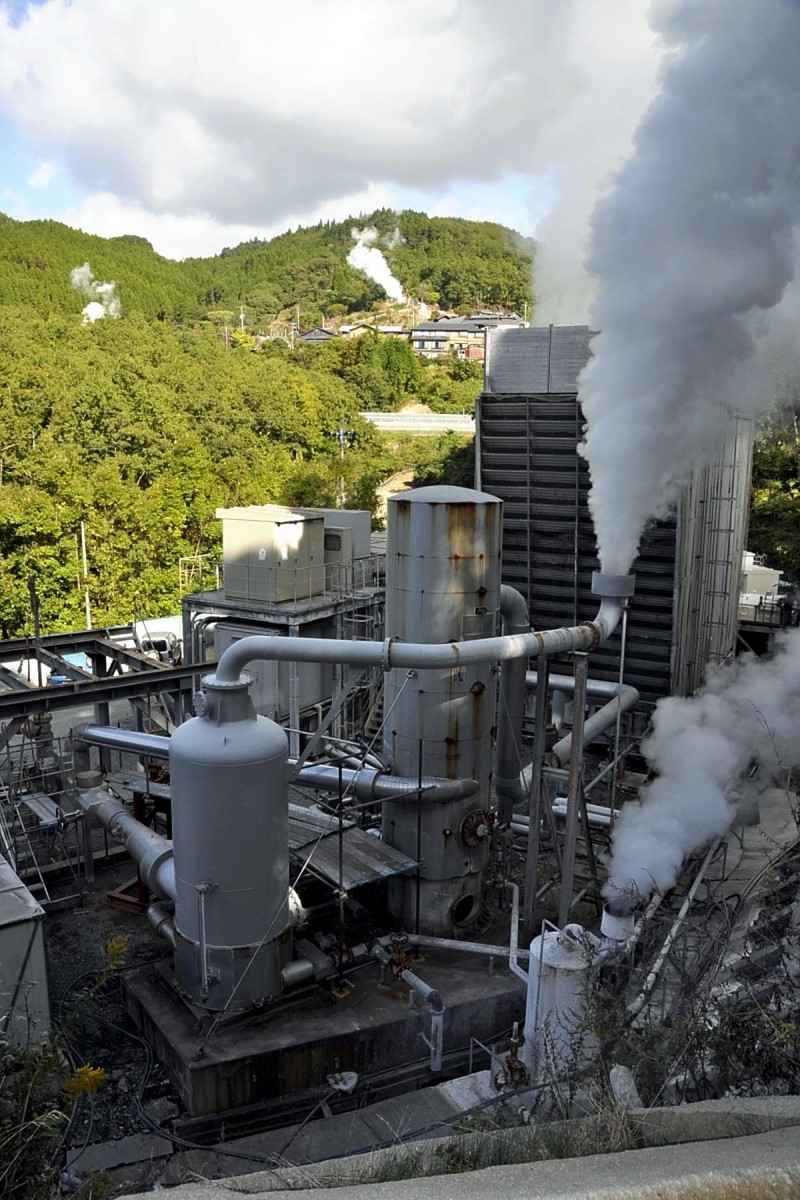Govt To Conduct Geothermal Excavation Surveys; Promising Renewable Power Source Is Costly to Develop

A geothermal power plant in Oguni, Kumamoto Prefecture, is seen in October 2021.
15:25 JST, November 19, 2024
Aiming to expand the generation and use of renewable energy, the economy ministry will launch a new initiative to encourage the development of geothermal power generation, as Japan has abundant geothermal resources.
Since high survey costs and the difficulty of negotiating with local communities are bottlenecks in expanding geothermal power generation, the central government will conduct excavation surveys for the sake of the private sector in order to lower barriers to enter the business. The government’s Strategic Energy Plan, which will be revised before the end of this fiscal year, will include measures to promote and support geothermal power development.
Under the new initiative, the government-affiliated Japan Organization for Metals and Energy Security (JOGMEC) will conduct an initial survey. The JOGMEC will find locations suitable for geothermal power generation based on soil surface temperatures and other data, perform excavations and explore subsurface structures. The government will take the lead in negotiating with local communities. If the government verifies the commercial feasibility of geothermal power generation in a certain location, it will publicly seek companies willing to develop it.
The Economy, Trade and Industry Ministry will select candidate sites for geothermal development in fiscal 2025 and start surveys as early as fiscal 2026. The ministry is considering securing necessary funds in the initial budget for fiscal 2026.
Geothermal power generation uses steam heated by magma deep underground to rotate a turbine for a generator and produce electricity. Japan, a volcanic country, is blessed with abundant geothermal resources capable of generating 23.5 gigawatts of electricity, the third largest potential production in the world after the United States with 30 gigawatts and Indonesia with 27.8 gigawatts. However, Japan’s installed capacity for geothermal power is only about 0.6 gigawatts partly because geothermal resources in the country are concentrated in natural parks where development is restricted.
Before building a new geothermal power plant, it is necessary to drill a hole to a depth of 1,000 to 2,000 meters to confirm there is a sufficient amount of geothermal steam to use for power generation. This initial survey alone costs more than ¥1 billion.
Moreover, there is only a 30% chance of success. Operators are sometimes forced to stop operations for reasons such as an insufficient amount of geothermal steam. Currently, there is a subsidy program to cover up to two-thirds of the excavation costs. However, if the development of a geothermal power plant results in failure, the companies concerned will incur losses not fully covered by the subsidy program.
When locations with a sufficient amount of geothermal steam are located near onsen hot spring areas, hot spring operators sometimes oppose the construction of a geothermal power plant because they are concerned about its impact on the amount and quality of hot spring water, causing companies to hesitate to develop geothermal power. Given these circumstances, if the central government conducts excavation surveys and negotiates with local communities, it could help proceed with necessary procedures more smoothly than now.
Geothermal power is expected to become a 100% domestic baseload renewable power source because, unlike solar power and wind power, it is capable of providing a stable supply of electricity around the clock regardless of the weather. The government aims for geothermal power to account for 1% of the country’s energy mix by fiscal 2030, compared to only 0.3% now. In addition, only 1.4% of renewable energy used in the country comes from geothermal power.
In the next Strategic Energy Plan, the proportion of renewable energy sources in the country’s power generation mix in fiscal 2040 will be raised from the current range of 36%-38% by means such as increasing geothermal power generation. The contribution of renewables is expected to exceed that of thermal power for the first time.
"Politics" POPULAR ARTICLE
-

Japan to Support Central Asian Logistics Route That Bypasses Russia, Plan to Be Part of Upcoming Summit in Tokyo
-

Japan to Tighten Screening of Foreigners’ Residential Status by Providing Information of Nonpayment of Taxes
-

Takaichi Cabinet Approval Holds at 72% as Voters Back Aggressive Fiscal Stimulus, Child Benefits
-

Chinese, Russian Bombers Flew Unusual Path by Heading Toward Tokyo; Move Likely Meant to Intimidate Japan
-

Takaichi Meets Many World Leaders at G20 Debut in Johannesburg; Speaks with Heads of Countries Including Italy, U.K., Germany, India
JN ACCESS RANKING
-

Keidanren Chairman Yoshinobu Tsutsui Visits Kashiwazaki-Kariwa Nuclear Power Plant; Inspects New Emergency Safety System
-

Imports of Rare Earths from China Facing Delays, May Be Caused by Deterioration of Japan-China Relations
-

University of Tokyo Professor Discusses Japanese Economic Security in Interview Ahead of Forum
-

Japan Pulls out of Vietnam Nuclear Project, Complicating Hanoi’s Power Plans
-

Govt Aims to Expand NISA Program Lineup, Abolish Age Restriction




-250x164.jpg)



















